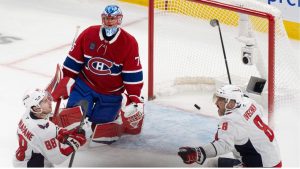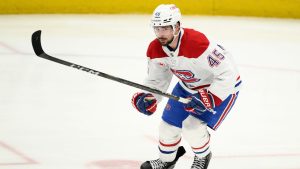VANCOUVER – Read these words carefully: the Vancouver Canucks lead the National Hockey League. In trades.
Tuesday’s deal that sent Luke Schenn, who left the Toronto Maple Leafs 11 years ago and didn’t miss a playoff series win while he was gone, back to centre of the hockey universe was the seventh trade orchestrated by rookie Canucks general manager Patrick Allvin since September. No other NHL team has been as active.
Trading Schenn was not an easy thing for Allvin, and the return of a third-round draft pick in June feels like the absolute minimum the Canucks should have considered for renting out their heart-and-soul defenceman, who badly wanted to finish his career close to home in Vancouver.
“It's a hard decision for different reasons,” Allvin told reporters a month ago. “I have a lot of respect for Luke Schenn as a person and what he brings in terms of winning habits. I mean, he won two Cups (with Tampa) and he's a very attractive player in what he brings here day to day. So that's definitely a hard one for us, but we also understand that he's a UFA.”
Maybe the Canucks can pull off the often-touted, seldom-executed trade-and-resign switcheroo. But they need to get better, and Schenn was a slam dunk for getting them an asset to help the construction.
And yet, Allvin is still just starting. He may pull off another deal before Friday’s deadline – or several trades based on the number of Canuck players trending on Twitter on the West Coast Tuesday afternoon.
The Canucks have a long way to go, as Allvin confirmed at his press conference in January when he hired Rick Tocchet to replace Bruce Boudreau as coach. So it’s seven trades and a coaching change.
“He asked me if this was a quick fix,” Allvin said. “And for me, it's not a quick fix. Where we are, it's a lot of work that needs to be done here.
“It's step by step, brick by brick. I'm really happy and proud of what we have accomplished off the ice. Changes are never easy. For me coming in here less than a year ago, looking over the structure of the hockey-ops, looking into the personnel around the team and the players, right now, I'm really happy with this staff and my colleagues that we have and the vision we have moving forward here. Again, it's not going to be a quick fix. It's got to be a lot of work and a lot of bumps on the road here, (but) we'll get it right.”
We can attest to the bumps in the road. The getting it right part will take longer to judge.
Projected deadline day cap space: $8.14 million
Cap space committed to 2023-24: $79.2 million (before LTI)
The Canucks need right-side defencemen and at least two top-four blue-liners, another centre, more team speed and physicality, players who can kill penalties, and greater prospect depth at all positions.
Draft picks
With the Schenn trade, Allvin now possesses seven picks in the first four rounds of the 2023 entry draft – two in each of those rounds except the second, pending what happens to the top-12 protected first-rounder the New York Islanders committed to the Canucks in the Bo Horvat trade.
Everyone in Canucks Nation would be happier if it was a second-rounder Leafs GM Kyle Dubas surrendered for Schenn. But then Toronto doesn’t actually have a second-rounder until 2026 and even Dubas isn’t desperate enough to give Vancouver the final pick of the first round that the Maple Leafs acquired Tuesday by sending Rasmus Sandin to Washington.
Seven picks in four rounds is nice for the Canucks, but eight would be better. It had been a decade since the team’s prospects cupboard looked as barren as it did when this season began. Allvin needs draft picks, lots of draft picks.
Jordan Greenway, LW, Minnesota
Tocchet has mentioned several times the need for more “wall guys” and “inside” players with physical heft, and the mobile, six-foot-six Greenway certainly fits that need. He looked a couple of years ago like he was turning into a formidable, two-way, middle-of-the-lineup player for the Wild but has seen his average ice time fall this season to 13:22, and Greenway has just two goals and six points in 43 games.
The drawback with Greenway, 26, is a contract that has two years remaining at $3 million. But the drawback with Canuck trade candidate Brock Boeser are the two more years he is owed at $6.65 million. Agent Ben Hankinson, empowered by Allvin in December to try to find a new home for Boeser, made it clear in an interview last week with The Athletic that he is trying to orchestrate a Minnesota homecoming for his client.
“I think he fits perfectly,” Hankinson said of Boeser and the Wild, “a top-six scoring wing, probably playing with (Matt) Boldy.”
To make any Boeser trade happen, the Canucks are going to have to take back some salary. Greenway may not be a perfect fit, but he’s the kind of player Vancouver needs.
Rasmus Kupari, C, Los Angeles
The Canucks acknowledged their need for centres when they prioritized the position in the Horvat trade, getting 20-year-old pivot prospect Aatu Raty from the Islanders. But he alone doesn’t solve the shortage of centres in the organization.
The Kings have so many centres that Kupari, a first-round pick from 2018, appears to be getting pushed down by the glass ceiling in Los Angeles. The fourth-liner’s ice time of 9:57 is down two minutes from last season, and the Finn has the talent to play higher. Kupari has just three goals and 10 points in 45 games this season, but he can skate and kill penalties and is a right-handed faceoff man who has won 52 per cent of his draws. And at age 22, he fits the Canucks’ desired template of a talented prospect coming out of his entry-level contract (Ethan Bear, Vitali Kravtsov, Jack Studnicka) who needs a little more development and opportunity.
Brock Boeser, RW
No Canuck looks forward to March 4 more than Boeser, who has played with the public burden of uncertainty since agent Hankinson got involved three months ago in Allvin’s trade mission to move the right winger somewhere he can play more minutes and higher up the lineup. At 26 and stalled annually by injuries, Boeser is still trying to match the 29 goals he scored as a Calder Trophy runner-up five years ago. This season, he has 11 goals and a respectable 38 points in 52 games, but his defensive profile has cratered. He is a classic example of the good-guy, talented player who has stagnated and needs a mid-career change.
Everybody likes Boeser’s offensive ability, but few teams like his current contract -- a three-year, $20-million bridge deal that was signed last summer. Were his salary cut in half, Boeser probably would have been traded long ago. But as his agent noted when talking about a potential trade to the Wild, the Canucks would need to retain a big chunk of Boeser’s salary and, also, Allvin is reluctant to do that. And therein lies the rub.
J.T. Miller, C/LW
Through the magic and impermanence of digital journalism, this space in this story prior to Tuesday’s transaction described the attractiveness of Schenn as a trade chip. Since Allvin played that chip pretty much the moment this piece was posted on Sportsnet.ca, we’re changing on the fly and putting Miller here. Like Miller, we really don’t think he’s going to be traded. But everyone seems to have so much darn fun speculating about the Canucks’ second-best forward that it felt we’d be doing a disservice to readers not to include him.
Miller is a big player with an equally big personality, and his emotional responses to almost everything that happens on the ice can be divisive. His season has been inconsistent, but the power forward is still on pace to finish with 27 goals and 74 points. And Miller has returned to top form under Tocchet, who has him working as hard defensively as Miller has ever worked. The problem is he carries a $56-million IOU with the seven-year extension he signed with the Canucks last summer. Despite a mammoth media hype train ahead of the last deadline, Miller generated few serious trade offers from other teams even as he was on his way to a 99-point season while on a bargain contract that had one year (this season) remaining. Now, in a lesser season for Miller, does it make sense that someone would be more eager to acquire him with a $56-million extension kicking in next fall when the player will be 30 years old? Maybe. It’s the NHL.
Tyler Myers, D
Since Allvin was hired by hockey operations president Jim Rutherford 13 months ago, they have talked about the need to shed salary and create some cap flexibility. So far, they have mostly failed at it, although Rutherford was adamant during a January press conference that the organization will do whatever it takes this summer to achieve some financial breathing room as the NHL roster is reconstructed. The biggest salary-cap drag, defenceman Oliver Ekman-Larsson, is currently injured and with four more years at an annual cap charge to the Canucks of $7.26 million, is untradeable. The next biggest cap release valve is Myers, a 33-year-old who has regressed this season in Year 4 of a five-year, $30-million contract he signed with previous GM Jim Benning.
Myers still has his moments as an experienced defender, and we’ve seen with the introduction of better structure under Tocchet an uptick in the six-foot-seven blue-liner’s play. But the balance owed on his contract is a massive trade impediment, especially a $5-million bonus payment due in July, so the questions for Allvin are simple: How badly do you want to move Myers’ salary and what are you willing to surrender to achieve it?








COMMENTS
When submitting content, please abide by our submission guidelines, and avoid posting profanity, personal attacks or harassment. Should you violate our submissions guidelines, we reserve the right to remove your comments and block your account. Sportsnet reserves the right to close a story’s comment section at any time.